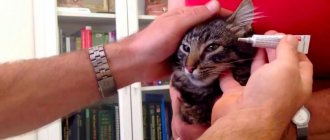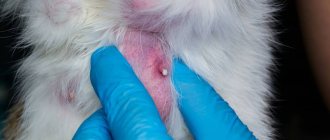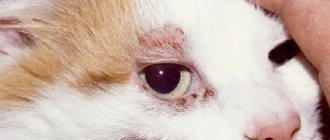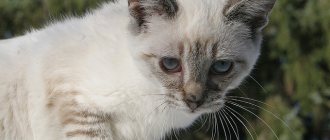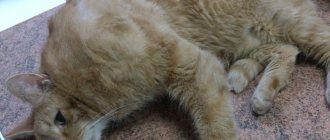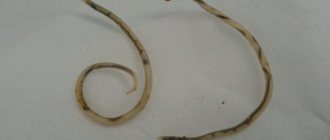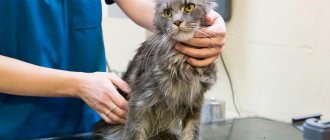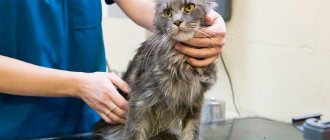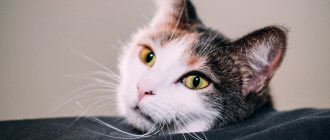6959Pavel
The cat is always the center of attention. It is impossible not to pay attention to it. Yes, she often reminds herself of herself. If a cat's tail is wet, the owner will immediately notice it.
This situation is not necessarily associated with something bad. First, you need to understand whether spilled oil or another substance is causing the problem. The cat could just get dirty. But if your tail is constantly wet, there may be several reasons.
© shutterstock
The cat's tail is wet - what should I do?
The cat is always the center of attention.
It is impossible not to pay attention to it. Yes, she often reminds herself of herself. If a cat's tail is wet, the owner will immediately notice it. This situation is not necessarily associated with something bad. First, you need to understand whether spilled oil or another substance is causing the problem. The cat could just get dirty. But if your tail is constantly wet, there may be several reasons.
Wet tail (colibacillosis)
Colibacillosis is an infectious disease accompanied by enteritis, also known as “wet tail”. Causes pathology E. coli. Normally, E. coli is present in the animal’s body, but under certain circumstances the number of bacteria can exceed the norm, resulting in disease.
It is assumed that the infection is transmitted through household items, through contact of a sick animal with a healthy one, and through airborne droplets.
Most often, hamsters, rats and mice suffer from the disease; Rabbits, guinea pigs and larger rodents get sick less often.
Natural cause in cats
Your cat may have a wet tail due to the onset of the reproductive estrous cycle, popularly called estrus. A similar condition occurs in cats during sexual arousal. At this time, the animal’s body prepares for the process of mating, fertilization and pregnancy.
Estrus occurs in 4 stages:
- proestrus - takes 1-3 days, the cat attracts cats to her, but does not let them get close;
- estrus – lasts about 5 days, mating occurs;
- diestrus – 2-19 days, excitement subsides, most often pregnancy occurs;
- anestrus - sexual rest.
A discharge under the tail appears during the mating stage. At this time, the animal does not look like itself, purrs, and shows excessive tenderness. It often licks its genitals, from which a clear secretion is released. The first heat can begin at the age of 4 to 18 months, depending on the breed. What to do in this case?
There may be several options. The cat can be matched with a male, sterilized, or wait until everything goes away on its own. But for this you will have to be patient. Typically, estrus goes away within 5-15 days. If this does not happen, you should contact your veterinarian.
General information, predisposing factors
This is the name of a skin disease of inflammatory etiology, which is accompanied by a rash, peeling of the skin, as well as the release of ichor and exudate (especially in places of folds) . The area of the muzzle, ears, neck, interdigital spaces, and, less commonly, other areas of the skin are severely affected. Veterinary statistics indicate that the disease is more common among kittens under one year of age, but (in much rarer cases) it also occurs in adult cats.
What are the causes of the disease? Such dermatitis is not contagious (however, it all depends on the root cause), it can be transmitted genetically, occur due to disruption of the digestive system (for example, intestinal dysbiosis), as well as due to contact of the skin and external irritants (household chemicals, pollen, paint products, etc.). Dermatitis is widespread in areas with high levels of environmental pollution. In particular, it is much more common in cats living in houses directly adjacent to streets with heavy traffic.
Pyometra
If estrus does not stop for a long time, a uterine infection may be suspected in the cat. This is a serious disease that threatens the life of the animal. It is impossible to do without veterinary control.
Pyometra occurs due to hormonal changes that occur in the genital tract of a mature cat. The cause of the disease is often pregnancy that does not occur within several heat cycles. During estrus, the cervix is slightly dilated. Because of this, bacteria enter the reproductive organ. If the walls of the uterus are thickened due to unsuccessful attempts to get pregnant, bacteria begin to develop in them.
The infection manifests itself as purulent vaginal discharge. They can be noticeable under the tail, on the fur, on the bed.
If the disease is confirmed, the specialist will recommend removal of the uterus and appendages.
Anal gland problem
Cats quite often have problems associated with the excretory system . If your cat has a wound under his tail that is not related to injury, you should consult a veterinarian. It can be caused by a blockage of the sebaceous glands near the anus.
The disease is called inflammation of the paraanal glands. The secretion from the glands spreads throughout the body and leads to inflammation of neighboring tissues. An abscess appears. Left untreated, it can make it difficult for your cat to go to the toilet. Then blood poisoning occurs.
When the glands under the tail become inflamed, you may notice a discharge with a strong odor, an ulcer, a fistula, or a lump.
The problem can be treated with medications and gland cleaning. To prevent it, it is important to balance the cat’s diet and monitor the condition of the sebaceous glands. Then it won’t be wet under your tail either.
Symptoms
Watery diarrhea, which leads to the characteristic “wet tail” symptom. However, loose stools appear last: initially, there is a lack of appetite and lethargy.
The incubation period of the disease is about 5-7 days.
Diarrhea does not always mean colibacillosis. Sometimes loose stools in an animal occur due to stress, changes in diet, and other “harmless” factors. Any diarrhea is a cause for concern, so you should contact your veterinarian at the first sign of it.
What are paraanal glands?
Anal (paraanal) glands are paired glands located at the anus. They look like small “bags” and secrete a secretion that performs various functions. One of them is recognizing the opposite sex and attracting them for further mating.
Other functions performed by the paraanal glands:
- protection from enemies (scaring away),
- marking the occupied territory,
- maintaining metabolism in the body,
- attracting partners.
During inflammatory processes, the functions of the glands are disrupted. Because of this, the pet experiences serious discomfort. In advanced cases (for example, with the development of an abscess), this problem can lead to serious and irreversible consequences. However, it is possible to avoid them if you know all the most important things about the causes and signs of inflammation.
Common Causes of Inflammation
Inflammation or abscess of the paraanal glands often develops with trauma and mechanical damage to this area (for example, falls from a great height). This leads to dysfunction of the glands, disruption of the outflow of secretions and its subsequent accumulation. All this provokes the development of an inflammatory process involving pathogenic microflora.
Most often, long-haired cats living in apartments face the problem of inflammation of the paraanal glands. This is due to the fact that they lose the natural ability to cleanse the anal sacs (due to the absence of potential enemies and the need to defend themselves from them).
Common causes of inflammation of the paraanal glands:
- dysbacteriosis (for example, due to prolonged use of antibiotic drugs by the pet),
- helminthic infestations,
- eating small bones
- feeding mass market liquid food,
- lack of physical activity,
- injuries to the anus and anal area,
- disorders of the gastrointestinal tract, accompanied by frequent constipation.
Older cats are more prone to inflammation and abscess of the anal glands. One of the factors that can affect the development of the inflammatory process is that the pet’s gland channels are too narrow from birth. Veterinarians include cat pregnancy and excess weight (obesity) as additional provoking factors.
Without timely veterinary care, the animal will develop complications. The inflammatory process can quickly develop into an abscess (purulent inflammation), which poses a threat not only to the health, but also to the life of your pet. That is why, when the first signs of a problem appear, you need to contact a veterinary clinic in Moscow as soon as possible.
Diagnostic techniques
Diagnosis is made through visual examination of the skin. The specialist must understand at what stage the development of the disease is, and also make an assumption about what exactly could have caused its appearance. The owner must give the specialist as complete information as possible about when and after what something wrong happens to the pet.
Monitoring symptoms (itching, rashes, peeling, frequency of new blisters) is of important diagnostic importance But identifying external signs of the disease is only half the battle. First, the doctor (if possible) must determine whether the pathology has occurred in your pet’s closest relatives. Secondly, and even more important, it is necessary to establish whether pathogenic and conditionally pathogenic microflora (and this almost always happens), and also to identify its exact type. The diagnosis is made, as a rule, in the presence of three or more symptoms characteristic of atopic dermatitis.
Signs of inflammation and abscess
Signs of inflammation develop gradually. They are accompanied by an increasing painful symptom. Due to pain and itching, the cat constantly licks the area of inflammation (tail and anus). The pet stops playing, spends time in solitude, practically does not move and constantly lies down. However, this is not the only symptom.
Other signs characteristic of inflammation of the paraanal glands:
- weakness,
- apathy,
- unpleasant specific odor from the pet’s body (does not disappear after washing),
- poor appetite (in later stages – refusal to eat),
- painful bowel movement,
- discharge from the anal glands.
With an abscess, this condition is accompanied by purulent or bloody discharge. In especially severe cases, body temperature rises. When stroking the affected area, the pet shows aggression and anxiety. Defecation is accompanied by severe pain, so the cat meows loudly on the tray.
Clinical picture
This disease is characterized by a relapsing course with exacerbations that occur more often in the warm season (more microorganisms). The main signs are: severe itching, which is why a sick cat can scratch the skin vigorously, sometimes until it bleeds; rashes on the affected skin, peeling, flaking; dry skin all over the body. Blisters and papules gradually form on the skin. They open, resulting in a large amount of ichor flowing onto the skin. Being contaminated with pathogenic and conditionally pathogenic microflora, the exudate begins to decompose and smell bad. All this not only causes your pet severe pain, but can also cause the development of septic phenomena.
Treatment: main stages and methods
Treatment of inflammation or abscess of the paraanal glands should only be carried out by an experienced veterinarian in Moscow. We strongly do not recommend trying to help your pet at home. This will only worsen an already difficult situation.
The first step in treating inflammation is diagnosing the animal's condition. The veterinarian examines the affected area, interviews the owner (about the severity of symptoms, the degree of their manifestation, etc.), after which he assesses the cat’s condition and prescribes treatment.
Cleaning
If you consult a doctor in a timely manner (at the first stage of the inflammatory process), then treatment will be limited to cleaning the paraanal glands. This procedure does not require special conditions, so it can be performed in the clinic or at home, but only by a professional veterinarian.
Before cleansing the glands of accumulated secretion and secretion, it is necessary to palpate them. This will allow you to determine the consistency of the contents and select a cleaning method. If the secretion is liquid, then the external method is used, if it is dense, the method of rectal sanitation is used.
Treatment
Antibacterial drugs are used
- tetracycline orally (dilute 0.3 g per 100 ml of water, check dosage with your veterinarian),
- subcutaneous injection with chloramphenicol (5 mg of the drug per 100 g body weight),
- Oral solution of metronizadol (1 tablet per 200 ml of water, give 1 ml per 350 g of live weight).
There is evidence of successful treatment of “wet tail” with Nifuroxazide (Ersefuril); by the way, this drug, like the other antibacterial agents listed above, is sold in regular pharmacies (they give 1 drop per 100 g of weight, 2-3 times a day).
Vaseline oil will reduce the irritating effect of toxins on the gastrointestinal tract (dosage: 2 drops per 50 g of weight).
You can give Linex and other similar drugs to restore normal intestinal microflora.
No-spa and papaverine will help reduce painful spasms (the dose is determined by the doctor). Medicines are soldered from a syringe without a needle or a small syringe.
To improve the condition of the animal and provide additional nutrition, you can inject glucose. Injections are administered 2-3 times a day to the withers area at the rate of 1 ml of 5% glucose solution per 100 g of animal body weight. Feeding with saline solution (0.9% sodium chloride) is also indicated.
Recovery after treatment
After cleaning, rinsing or removing the anal glands, your cat requires special care. This will allow her body to recover faster and avoid unwanted consequences. The first thing that is necessary is to ensure the pet's comfort. Set up a bed for him in a warm place without drafts or blowing.
Maintain a therapeutic diet for 10-14 days. Eliminate solid food completely and provide constant access to fresh drinking water. Avoid excess carbohydrates in your animal's diet. It must be completely balanced so that the cat quickly recovers from a severe inflammatory process.
Prevention of inflammation of the paraanal glands
Inflammation and abscess of the paraanal glands are a serious blow to your cat's health. However, it is possible to avoid it. The main thing is to follow simple recommendations for prevention from experienced veterinarians.
- Your pet should lead an active lifestyle (in accordance with its age). If you don't have much time, special toys and exercise equipment for cats will help with this.
- If your animal's anal glands are often clogged, consult a specialist and discuss the issue of removing them.
- Try to avoid cheap liquid food and do not give your pet small bones, as well as foods that can cause gastrointestinal injury.
- At the first signs of inflammation, consult a doctor. Don't forget about regular preventive examinations.
- Carry out anthelmintic treatment once every 6-12 months. This completely eliminates the possibility of developing parasitic diseases.
Inflammation or abscess of the paraanal glands is dangerous to the health and life of the cat. A seemingly insignificant problem can lead to dangerous consequences, including death. That is why we strongly recommend that you follow preventive measures, and if the first signs of inflammation appear, contact your veterinarian immediately!
Source
Prevention, advice to owners
In the treatment and prevention of “wet tail”, it is important to follow the rules of hygiene - clean the cage in a timely manner, replace food and water daily, wash your hands after interacting with animals (since the infection is easily transmitted from one rodent to another).
If several animals are kept in one cage, then the sick should be immediately isolated and the cage should be thoroughly cleaned.
Further care should begin with healthy pets, and then only carry out hygiene procedures on sick animals.
It is not advisable to keep a sick pet in the same room as healthy ones.
Several times a day, the cage of a sick rodent is disinfected with antiseptics and the bedding is changed - these actions help to avoid re-infection.
Causes of discharge from the anus
Discharge in a cat during diarrhea or constipation is quite normal and quite common. They manifest themselves in different ways, but are fairly easy to identify, so they are not too dangerous. The owner may also notice a small amount of blood clots in them. This symptom disappears completely with complete recovery. Therefore, you should not worry too much about this.
But if the discharge from either the anus in a cat or the vaginal area in a cat is purulent or mucous in nature and has a characteristic odor, we can talk about the presence of an infection.
Often this can be associated with problems with the genital organs of cats. But there are other options that require careful testing, special tests and smears. Here you should seek the help of a specialist as soon as possible so as not to aggravate the situation and alleviate the cat’s suffering.
© shutterstock
Often the cause of discharge from the anus is inflammation of the paraanal glands. Previously, many were inclined to think that such problems were directly related to the abundant use of dry food in the diet of pets. However, it turned out that this is a myth. Often, discharge appears due to the unusual structure of the intestine itself . For example, you may notice frequent attempts by the animal to sit on its hind legs or walk along the floor. Such manifestations of attempts to get rid of excess secretions should be immediately noticeable to the owner.
A cat has a greasy tail: what to do?
What is greasy tail syndrome?
The fur on the tail of cats can be greasy almost all the time. Sometimes one or more greasy spots appear on the tail, and sometimes the tail becomes “greasy” completely. The degree of “greasy” may vary. In some cats, the coat becomes oily only at the base, in others - all the way to the tip. Frequent bathing and washing with degreasers usually do not help. After a short time, the tail becomes “greasy” again.
This problem is called “greasy tail syndrome.”
Why does the tail become greasy?
Cats have sebaceous glands on their tail. They produce sebum, which moisturizes and protects the skin. Sometimes the sebaceous gland produces too much secretion - in such cases, greasy spots appear on the tail or it becomes completely “dirty”.
The reasons for the increased production of sebum have not yet been sufficiently studied, but veterinarians associate them with the pet’s hormonal levels, an unbalanced diet and lifestyle in general. Most often, unneutered cats experience “greasy tail syndrome.” As well as pets that are kept in unfavorable, stressful conditions, for example, in cages in a shelter.
Is sebaceous tail syndrome dangerous?
A greasy tail is not life-threatening for your pet and usually does not affect its well-being. This problem is considered cosmetic. The owners are concerned about the cat's unkempt appearance, and they try to wash the tail so that the fur becomes beautiful again.
However, the problem cannot be underestimated. Due to the increased production of sebum, black crusts, comedones (white and blackheads) and even boils can form on the tail. The skin may become irritated and injured. There is a risk of bacterial and fungal infection, and severe dermatitis with accompanying itching and flaking may occur. Therefore, there is no point in doing nothing. The condition of the coat needs to be put in order. But how to do that?
Why doesn't washing help?
When an owner sees a cat’s tail being greasy, he decides to wash his pet – and this desire is completely understandable. After washing, the tail fur may look fresh and clean. But a little time passes - and the tail becomes even fatter than it was before. What to do? Wash again?
Frequent washing and the use of aggressive degreasers is a common mistake that owners make. The more often the tail gets dirty, the more often they try to wash it and the more diligently they experiment with shampoos: what if this one finally helps? But how does the sebaceous gland behave? She begins to produce even more sebum.
When you wash off all the protection (fat) from the skin, the sebaceous glands begin to produce secretions even more intensely to compensate for the loss and restore protection. As a result, the tail becomes even dirtier. The more often you wash your cat and the more aggressive products you use, the faster the tail becomes fat again.
But this does not mean that bathing cannot solve the problem. Maybe so. You just need to bathe correctly.
To begin with, do not try to solve the problem in one go: it is impossible. It takes time to normalize the functioning of the sebaceous glands. The “like with like” principle works here, i.e. fat must be washed away with fat. Do not use degreasers, but, on the contrary, maximally moisturizing conditioners, masks and oils. Skin that is well moisturized from the outside will, over time, stop producing excess secretions.
It is better to focus on professional care products: this is not an excess, but a necessary measure for the health and beauty of the coat. Under no circumstances should you wash your cat with soap, your own or baby shampoo, or any other products not intended for cats. This will only worsen the problem, and in addition can result in severe allergies, dandruff and itching.
A good groomer will help you choose the most effective products specifically for your case. Don't be lazy to make an appointment. A consultation with a good specialist will save you a fair amount of time and money that you would otherwise spend on purchasing and testing a wide variety of shampoos and sprays.
How to deal with greasy tail?
What to do besides proper bathing?
The main thing is to consult a veterinarian. It is better to exclude possible health problems that could affect the cat’s appearance, or to identify them in a timely manner.
Your other steps are to reconsider the diet and living conditions in general. Increased production of skin secretions may be associated with feeding errors (for example, if you feed your cat fatty meat), a lack of vitamins and minerals in the body, hormonal disorders or stress. It is best to discuss all this with your veterinarian.
We wish your pets the most beautiful tails!

